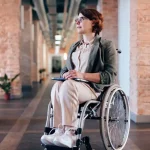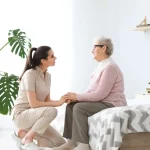What to do About Shoes for Seniors
First, are you wearing shoes? Finding just the right shoes for seniors can sometimes be a challenge.
Sit down and take a good look at your shoes.
You should, even when you are in the house. Shoes matter, mostly because they protect your feet and maintain your mobility on your own two feet.
Often, seniors get too comfortable in their old shoes. Shoes worn-out, smelly, have worn-down heels, have no laces, or rub your toes are not fit for your feet.
Smelly, sweaty shoes may have fungus on the inside, and if your shoes have it, so do your feet.
Poorly fitting shoes?
If the shoes are rubbing your toes or pinching your toes, then your toes are affected by the abrasion and probably have corns and callouses.
The old shoes you are wearing are possibly causing more problems than you realize. If you are like older people, your feet have become wider and flatter over time. You likely have dry skin and brittle toenails.
It’s best to get rid of them.
Do you usually wear slippers?
“Slippers and slip-on shoes are apt to cause the wearer’s heel to withdraw from the shoe; they also increase toe flexion during the swing phase of gait to retain the slipper on foot.” according to physical therapist Joan Edelstein of the New York University School of Medicine.
In other words, stepping out of slippers and trips is easy.
Are you a flip-flop wearer?
Then, you are taking the risk of damaging your toes or toenails if you drop something.
Also, a flip-flop is easy to trip over, and tripping leads to falling. Flip-flops are not for you.
Regular changes of shoes and regular care of feet are very important for elders who may have less feeling in their feet or are less aware of their pain.
So, what are the best shoes for seniors to wear?
In her article in Physical Therapy, Edelstein gives some good advice for seniors in choosing shoes.
- First, new shoes must be comfortable. Increase your wear time gradually to guard against shoes that cause pain.
- Consider the shoe’s length, width, capacity, and shape. Ask a caregiver or shoe salesperson to trace the outline of both of your feet while you are standing. Use this outline to judge shoes and their length and width. There may be a size difference between feet. Choose a size that fits the larger foot. The shoe for the smaller foot can have an insert put in to make it fit better.
- Choose a shoe with an upper section of soft leather or heavy fabric. The weight of the shoe should also be considered for a frail patient. The surface should be easy to keep clean.
- Get shoes that are close in a way that is easily managed. A person who cannot tie laces may be able to use a VELCRO brand touch fastener flap or a buckle that can be adjusted by hand, foot, or cane.
- The back of the shoe should be stabilizing to the ankle and heel. The heel should be compressible, low, and broad.
- A solid, thick sole is very important to mobility. Non-skid soles, like sneakers and sports shoes, provide good traction. Patients with Parkinson’s may find that smooth soles help them move more smoothly.
Healthy Feet
If you have callouses, bunions, ingrown toenails, or foot pain, then seeing a foot doctor or a podiatrist can help you resolve these problems.
The doctor can also help you improve your shoes’ fit for your feet. There are a variety of adaptations possible, from custom-fit shoes to inserts, shields, and cushions that fit in shoes.
Take a look at your shoes. Do you need to go shopping for some good shoes for seniors?
New shoes that help your feet, rather than hurt, are worth the money.
*”Foot Care for the Aging” by Joan E. Edelstein, MA. P.T., in Physical Therapy, Vol. 68, Number 12, 1988.

